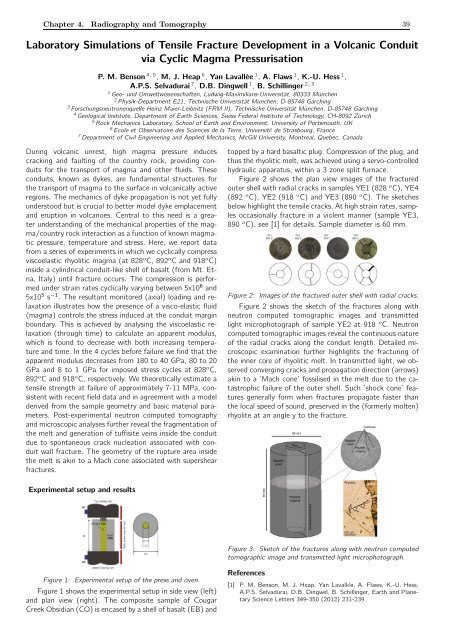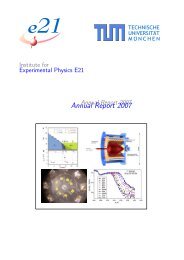Annual Report 2011 / 2012 - E21 - Technische Universität München
Annual Report 2011 / 2012 - E21 - Technische Universität München
Annual Report 2011 / 2012 - E21 - Technische Universität München
You also want an ePaper? Increase the reach of your titles
YUMPU automatically turns print PDFs into web optimized ePapers that Google loves.
Chapter 4. Radiography and Tomography 39<br />
Laboratory Simulations of Tensile Fracture Development in a Volcanic Conduit<br />
via Cyclic Magma Pressurisation<br />
P. M. Benson 4, 5 , M. J. Heap 6 , Yan Lavallée 1 , A. Flaws 1 , K.-U. Hess 1 ,<br />
A.P.S. Selvadurai 7 , D.B. Dingwell 1 , B. Schillinger 2, 3<br />
1 Geo- und Umweltwissenschaften, Ludwig-Maximilians-Universität, 80333 München<br />
2 Physik-Department <strong>E21</strong>, <strong>Technische</strong> Universität München, D-85748 Garching<br />
3 Forschungsneutronenquelle Heinz Maier-Leibnitz (FRM II), <strong>Technische</strong> Universität München, D-85748 Garching<br />
4 Geological Institute, Department of Earth Sciences, Swiss Federal Institute of Technology, CH-8092 Zürich<br />
5 Rock Mechanics Laboratory, School of Earth and Environment, University of Portsmouth, UK<br />
6 Ecole et Observatoire des Sciences de la Terre, Université de Strasbourg, France<br />
7 Department of Civil Engineering and Applied Mechanics, McGill University, Montreal, Quebec, Canada<br />
During volcanic unrest, high magma pressure induces<br />
cracking and faulting of the country rock, providing conduits<br />
for the transport of magma and other fluids. These<br />
conduits, known as dykes, are fundamental structures for<br />
the transport of magma to the surface in volcanically active<br />
regions. The mechanics of dyke propagation is not yet fully<br />
understood but is crucial to better model dyke emplacement<br />
and eruption in volcanoes. Central to this need is a greater<br />
understanding of the mechanical properties of the magma/country<br />
rock interaction as a function of known magmatic<br />
pressure, temperature and stress. Here, we report data<br />
from a series of experiments in which we cyclically compress<br />
viscoelastic rhyolitic magma (at 828 o C, 892 o C and 918 o C)<br />
inside a cylindrical conduit-like shell of basalt (from Mt. Etna,<br />
Italy) until fracture occurs. The compression is performed<br />
under strain rates cyclically varying between 5x10 6 and<br />
5x10 5 s −1 . The resultant monitored (axial) loading and relaxation<br />
illustrates how the presence of a visco-elastic fluid<br />
(magma) controls the stress induced at the conduit margin<br />
boundary. This is achieved by analysing the viscoelastic relaxation<br />
(through time) to calculate an apparent modulus,<br />
which is found to decrease with both increasing temperature<br />
and time. In the 4 cycles before failure we find that the<br />
apparent modulus decreases from 180 to 40 GPa, 80 to 20<br />
GPa and 8 to 1 GPa for imposed stress cycles at 828 o C,<br />
892 o C and 918 o C, respectively. We theoretically estimate a<br />
tensile strength at failure of approximately 7-11 MPa, consistent<br />
with recent field data and in agreement with a model<br />
derived from the sample geometry and basic material parameters.<br />
Post-experimental neutron computed tomography<br />
and microscopic analyses further reveal the fragmentation of<br />
the melt and generation of tuffisite veins inside the conduit<br />
due to spontaneous crack nucleation associated with conduit<br />
wall fracture. The geometry of the rupture area inside<br />
the melt is akin to a Mach cone associated with supershear<br />
fractures.<br />
topped by a hard basaltic plug. Compression of the plug, and<br />
thus the rhyolitic melt, was achieved using a servo-controlled<br />
hydraulic apparatus, within a 3 zone split furnace.<br />
Figure 2 shows the plan view images of the fractured<br />
outer shell with radial cracks in samples YE1 (828 o C), YE4<br />
(892 o C), YE2 (918 o C) and YE3 (890 o C). The sketches<br />
below highlight the tensile cracks. At high strain rates, samples<br />
occasionally fracture in a violent manner (sample YE3,<br />
890 o C), see [1] for details. Sample diameter is 60 mm.<br />
Figure 2: Images of the fractured outer shell with radial cracks.<br />
Figure 2 shows the sketch of the fractures along with<br />
neutron computed tomographic images and transmitted<br />
light microphotograph of sample YE2 at 918 o C. Neutron<br />
computed tomographic images reveal the continuous nature<br />
of the radial cracks along the conduit length. Detailed microscopic<br />
examination further highlights the fracturing of<br />
the inner core of rhyolitic melt. In transmitted light, we observed<br />
converging cracks and propagation direction (arrows)<br />
akin to a ’Mach cone’ fossilised in the melt due to the catastrophic<br />
failure of the outer shell. Such ’shock cone’ features<br />
generally form when fractures propagate faster than<br />
the local speed of sound, preserved in the (formerly molten)<br />
rhyolite at an angle y to the fracture.<br />
Experimental setup and results<br />
Figure 3: Sketch of the fractures along with neutron computed<br />
tomographic image and transmitted light microphotograph.<br />
Figure 1: Experimental setup of the press and oven.<br />
Figure 1 shows the experimental setup in side view (left)<br />
and plan view (right). The composite sample of Cougar<br />
Creek Obsidian (CO) is encased by a shell of basalt (EB) and<br />
References<br />
[1] P. M. Benson, M. J. Heap, Yan Lavallée, A. Flaws, K.-U. Hess,<br />
A.P.S. Selvadurai, D.B. Dingwel, B. Schillinger, Earth and Planetary<br />
Science Letters 349-350 (<strong>2012</strong>) 231-239.




